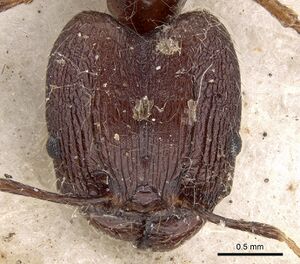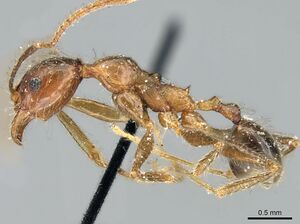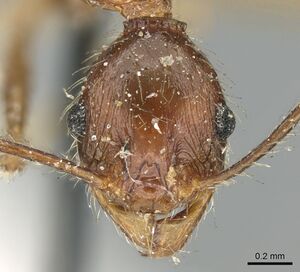Pheidole impressiceps
| Pheidole impressiceps | |
|---|---|

| |
| Scientific classification | |
| Kingdom: | Animalia |
| Phylum: | Arthropoda |
| Class: | Insecta |
| Order: | Hymenoptera |
| Family: | Formicidae |
| Subfamily: | Myrmicinae |
| Tribe: | Attini |
| Genus: | Pheidole |
| Species: | P. impressiceps |
| Binomial name | |
| Pheidole impressiceps Mayr, 1876 | |
| Subspecies | |
| |
Identification
Distribution
Latitudinal Distribution Pattern
Latitudinal Range: -3.089444444° to -16.98333333°.
| North Temperate |
North Subtropical |
Tropical | South Subtropical |
South Temperate |
- Source: AntMaps
Distribution based on Regional Taxon Lists
Australasian Region: Australia (type locality).
Indo-Australian Region: New Guinea.
Distribution based on AntMaps
Distribution based on AntWeb specimens
Check data from AntWeb
Countries Occupied
| Number of countries occupied by this species based on AntWiki Regional Taxon Lists. In general, fewer countries occupied indicates a narrower range, while more countries indicates a more widespread species. |

|
Estimated Abundance
| Relative abundance based on number of AntMaps records per species (this species within the purple bar). Fewer records (to the left) indicates a less abundant/encountered species while more records (to the right) indicates more abundant/encountered species. |

|
Biology
Castes
Images from AntWeb
   
| |
| Worker. Specimen code casent0281730. Photographer Estella Ortega, uploaded by California Academy of Sciences. | Owned by NHMUK, London, UK. |
   
| |
| Worker (major/soldier). Specimen code casent0281731. Photographer Estella Ortega, uploaded by California Academy of Sciences. | Owned by NHMUK, London, UK. |
   
| |
| Worker (major/soldier). Specimen code casent0906616. Photographer Estella Ortega, uploaded by California Academy of Sciences. | Owned by NHMW, Vienna, Austria. |
   
| |
| Worker. Specimen code casent0906617. Photographer Estella Ortega, uploaded by California Academy of Sciences. | Owned by NHMW, Vienna, Austria. |
Nomenclature
The following information is derived from Barry Bolton's Online Catalogue of the Ants of the World.
- impressiceps. Pheidole impressiceps Mayr, 1876: 105 (s.w.) AUSTRALIA. Forel, 1902h: 433 (q.). Current subspecies: nominal plus commista.
Type Material
- Syntype, 4 workers, Rockhampton, Queensland, Australia, Naturhistorisches Museum Wien, Vienna.
Description
References
- Forel, A. 1902j. Fourmis nouvelles d'Australie. Rev. Suisse Zool. 10: 405-548 (page 433, queen described)
- Mayr, G. 1876. Die australischen Formiciden. J. Mus. Godeffroy 12: 56-115 (page 105, soldier, worker described)
References based on Global Ant Biodiversity Informatics
- Andersen A. N., J. C. Z. Woinarski, and B. Hoffman. 2004. Biogeography of the ant fauna of the Tiwi Islands, in northern Australia's moonsoonal tropics. Australian Journal of Zoology 52: 97-110.
- Andersen A. N., M. Houadria, M. Berman, and M. van der Geest. Rainforest ants of the Tiwi Islands: a remarkable centr of endemism in Australia's monsoonal tropics. Insectes Sociaux 59: 433-441.
- Andersen, Alan N., John C.Z. Woinarski and Ben D. Hoffman. 2004. Biogeography of the ant fauna of the Tiwi Islands, in northern Australia's monsoonal tropics. Australian Journal of Zoology 52: 97-110.
- Bluthgen N., G. Gebauer, and K. Fiedler. 2003. Disentangling a rainforest food web using stable isotopes: dietary diversity in a species-rich ant community. Oecologia 137: 426-435.
- Janda M., G. D. Alpert, M. L. Borowiec, E. P. Economo, P. Klimes, E. Sarnat, and S. O. Shattuck. 2011. Cheklist of ants described and recorded from New Guinea and associated islands. Available on http://www.newguineants.org/. Accessed on 24th Feb. 2011.
- Room P. M. 1975. Diversity and organization of the ground foraging ant faunas of forest, grassland and tree crops in Papua Nez Guinea. Aust. J. Zool. 23: 71-89.
- Room, P.M. 1975. Relative Distributions of Ant Species in Cocoa Plantations in Papua New Guinea Relative Distributions of Ant Species in Cocoa Plantations in Papua New Guinea. Journal of Applied Ecology 12(1):47-61
- Sagata, K., A.L. Mack, D.D. Wright and P.J. Lester. 2010. The influence of nest avaiability on the abundance and diversity of twig-dwelling ants in a Papua New Guinea forest. Insectes Sociaux 57:333-341
- Snelling R. R. 1998. Insect Part 1: The social Hymenoptera. In Mack A. L. (Ed.) A Biological Assessment of the Lakekamu Basin, Papua New Guinea, RAP 9. 189 ppages
- Snelling R. R. 2000. Ants of the Wapoga river area, Irian Jaya, Indonesia. In Mack, Andrew L. and Leeanne E. Alonso (eds.). 2000. A Biological Assessment of the Wapoga River Area of Northwestern Irian Jaya, Indonesia. RAP Bulletin of Biological Assessment 14, Conservation International, Washington, DC.
- Taylor R. W., and D. R. Brown. 1985. Formicoidea. Zoological Catalogue of Australia 2: 1-149.

